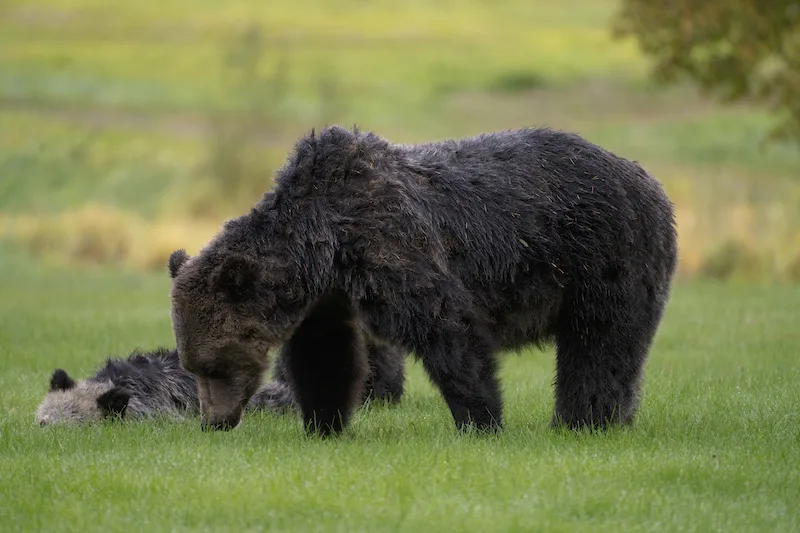
Discover British Columbia's Great Bear Rainforest
This unique, thriving ecosystem is the home of hundreds of grizzly bears.
When you walk through the Great Bear Rainforest it feels like you are on the edge of the world. The rainforest is 6.4 million hectares, and is actually part of the largest coastal temperate rainforest on earth, and sadly also the last coastal temperate rainforest left intact.
The rainforest stretches from Discovery Island in the south to the British Columbia-Alaska border in the North. It is home to thousand-year-old western red cedars and 90-meter-tall Sitka spruce trees. As well as an abundance of wildlife included several different species of salmon, wolves, and bears, hence the name.
Because of its ecological importance, many environmental groups have fought to protect the land, which was once at risk for logging. In 2016, the Government of British Columbia announced an agreement to permanently protect 85 per cent of the old growth forested area. But despite this big step forward, the Great Bear Rainforest still faces natural threats that are a growing concern for the wildlife that calls this place home.
And that is why The Weather Network made a trip down to Bella Coola, right on the edge of the rainforest. We wanted to find out more about this incredible land, and why we need to work together to protect it now more than ever before. We also had a chance to get to know one of the region's most abundant residents: the grizzly bear.

Image: Mia Gordon
The Canadian grizzly bear population is estimated to be around 26,000. More than half of the bears' population lives in British Columbia, and in the Great Bear Rainforest you can find about 1,400.
We had a chance to see the bears in the natural environment while visiting the Tweedsmuir Park Lodge in Bella Coola. Every day we would explore the region either by a walk or river float, learning all about the bear’s behaviors, culture, and of course how they interact with nature.
Ellie Lamb is a wildlife guide at Tweedsmuir Park Lodge, and her passion is trying to help guests understand these animals.
“The biggest challenge grizzly bears face is our own fear, as humans, of grizzly bears,” explained Lamb. “We need to understand that they are extremely evolved animals. They have community. Their mothers teach them where to hunt and who to trust. They have culture and traditions. They have a social structure. They are amazing animals and in taking people out and letting them experience the world they create it will allow us to understand them better and want to take care of them.”
During our time in the rainforest, we actually ran into the same family every day. A mom, known in this area as Perfect, and her two cubs. It was an incredible experience to be able to watch these bears over several days. She seemed to trust our guide Ellie and would allow us to get quite close. We were able to see how she interacts with her cubs and some of the hunting and feeding techniques she was teaching her cubs and some of her unique behavioral patterns.
During the days in the rainforest, the guides also taught us more about the grizzly bears' home. They pointed out features like rub trees, which are used for communication, cozy spots where they build napping nests, and the remains of dug up wild carrots. But our walks also unveiled some more concerning features as well.
We watched from the side of a river bank as one individual, Perfect, tried to catch a salmon for her and her cubs. I asked Lamb about this year’s salmon run and she told us it wasn’t great.
“The pink run was extremely low and the Chinook and ‘king’ salmon were also not that great.”

Image: Mia Gordon.
Lamb has been worried about Perfect and her cubs. They were late going into hibernation this year and there wasn’t much fish around. They were trying to find alternative food, and even coming onto the lodge feasting on grass. This year Lamb had also seen some familiar females that had cubs last year return solo, meaning that the babies did not survive the winter.
Back in the 1970s the Canadian government opened up Snootli Creek Hatchery in Bella Coola to try and rehabilitate the chum population. It is currently undergoing a five year, $20.4-million renovation to modernize infrastructure and improve operations. And while there has been some support for certain salmon species, others continue to suffer in the area, and as the climate changes, and the waters get warmer, the situation is only getting worse for the salmon, and therefore also the bears.
The grizzly bears have been forced to adapt. Before hibernation, the bears need to bulk up, usually eating 90 pounds of food per day ahead of time. Some bears have turned to other food sources like berries and carrots, while others have decided to travel further distances in search of salmon.
Sadly some bears have wandered into residential communities in search of food. While hunting grizzlies is banned in B.C., every year there are still several bears that are killed because of human conflict.
The reason these signs are so concerning is because grizzly bear populations can decline quickly since they are one of the slowest reproducing land mammals. A female may only have 8 cubs in her 25-year life span. They are currently considered a species at risk.
In hopes of finding ways to protect the bears, the team at Tweedsmuir Lodge has been working with a group of researchers with the BearID Project. Over the last few years, they have been working on new and innovative technology like face recognition that can monitor the bears, track any threats in their environment, and keep track of their health, to hopefully keep the grizzly bear population of the Great Bear Rainforest thriving.










